Morphy Richards Salisbury Door Chime 1964

Morphy-Richards Salisbury Long Bell Door Chime 1964
This mid-century chime has clean lines,a pearlescent painted cover and a simple brass crown ornament. Manufactured by Morphy-Richards in England, the Salisbury is described Ina 1964 pocket catalog:
SALISBURY The lacquered brass tubes produce two mellow notes which sound a real welcome to callers. This model is suitable for front-and back-door operation and works from internal batteries or from a a mains transformer. Height 34 1/2″, width 7″
A more angular model, the “Canterbury” was on offer simultaneous to the Salisbury.
On close examination, the placement of the shorter tube on the left side and the longer on the right varies from virtually all other long-bell door chimes where the shorter tube is on the right side. The instructions included with this example clearly direct the shorter tube be installed on the left side yet the catalog curiously shows the opposite orientation. If the longer tube were on the left as depicted in the catalog, the chime would produce a “dong-ding” sound instead of the expected “ding-dong”. The marketing depiction may be due to an error on the part of the catalog’s art director or evidence this particular Salisbury is an earlier or later production model than those offered in 1964.
Although a battery facility is common to several other British long-bell door chimes, the battery requirement is worth noting. The instructions specify:
Your Chime may be used with either two 4 1/2 volt flash-lamp batteries (we recommend Ray-O-Vac 15LP)… For Battery Operation: Bend the long brass strip on one battery and the short brass strip on the other back along the curved sides and insert the batteries upside-down in the compartment on the baseplate.
Today, a Ray-O-Vac 15LP battery would be next to impossible to find. As near as I can tell, two IEC 3LR-12 (alkaline) or IEC 3R12 (carbon-zinc) batteries will fit, although these too will be difficult to obtain.
This Salisbury can be accurately dated to the 1960s as Morphy-Richards manufacturing ceased in Kent in 1970.
| Manufacturer | Morphy-Richards LTD |
| Location of Manufacture | St. Mary Cray, Kent, England |
| Date of Manufacture | ~1964 |
| Cover | Painted stamped steel with brass ornaments |
| Mechanism | Steel |
| Bells | Brass |
| Width | 7 inches |
| Height | 34 1/2 inches |
| Depth | 2 1/2 inches |
| Notes | ElectraChime Collection |
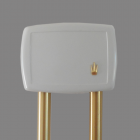
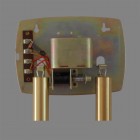
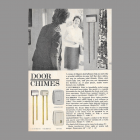
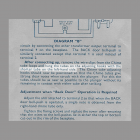
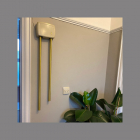
So glad I found this listing. Just what I needed to help me fix mine, as well as date it.
Lovely period chime.
It’s great that I found this post as I recently moved into a house that has one of these doorbells. I would love to get it working and I have ordered the batteries, some wire and a bell push. I wonder if it possible to get a bit more details on installing the batteries and wiring the push button please?
Hello, standard wired doorbell wiring will apply. Any electrician or handyman will be able to hook it up. You may want to google battery operated door chime schematic for additional information.
I have a Morphy Richards compact chime, whose internals look almost identical to the Salisbury, except for the internal spring-suspended chimes. What I don’t understand is what the rounded metal structure above the solenoid is for. It contains a printed circuit board with just two copper strips, with no apparent connection between them. What does this do?
Also, I have tried applying 12 volts across the 2nd and 4th terminals (i.e. the solenoid) and it doesn’t seem to throw the armature far enough to hit the first chime. (The second one is struck when the spring pulls the armature back.) The resistance across the solenoid is about 5 ohms, with the piece of bell wire I’m using adding another 1-2 ohm. Thus, I ought to be getting enough current flowing. Should I lubricate the armature? Any ideas gratefully received.
Do not lubricate or oil. Without photos, I am unable to help further.